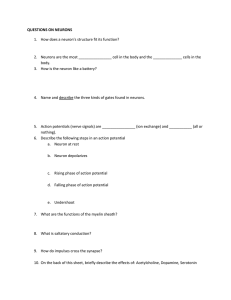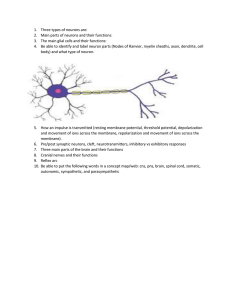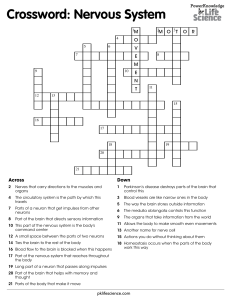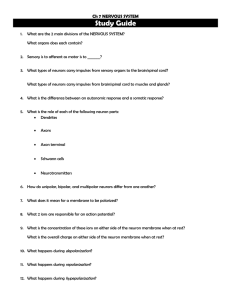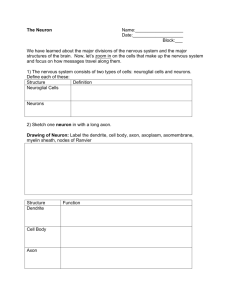File - Ms. Drozd - Human Body systems
advertisement
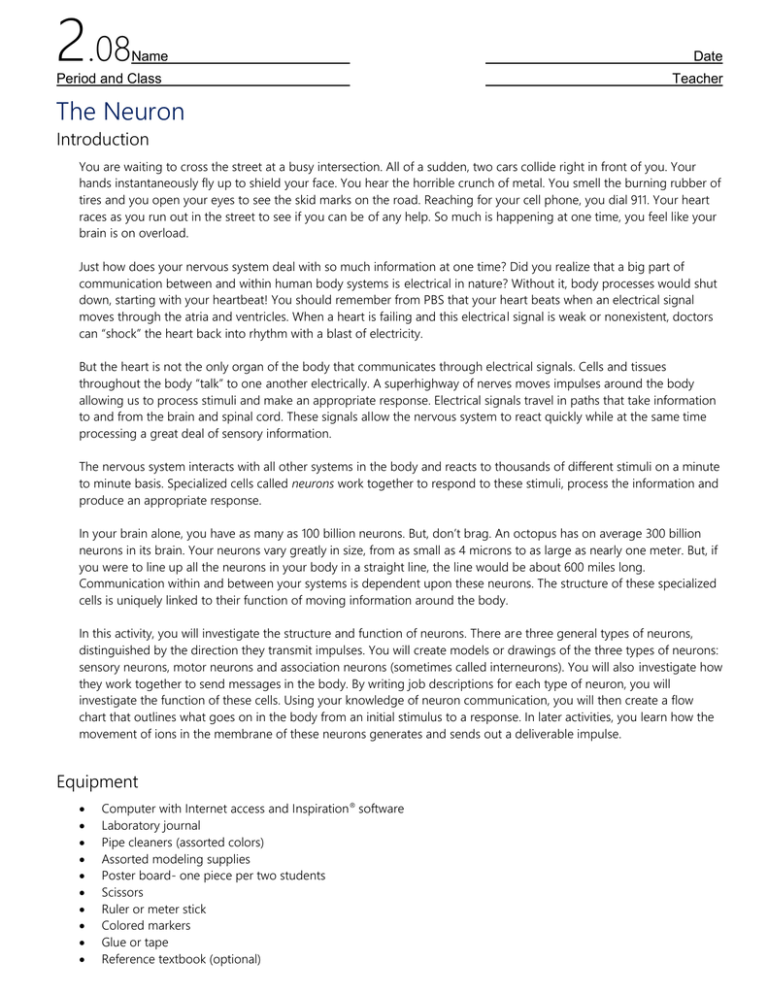
2.08 Name Period and Class Date Teacher The Neuron Introduction You are waiting to cross the street at a busy intersection. All of a sudden, two cars collide right in front of you. Your hands instantaneously fly up to shield your face. You hear the horrible crunch of metal. You smell the burning rubber of tires and you open your eyes to see the skid marks on the road. Reaching for your cell phone, you dial 911. Your heart races as you run out in the street to see if you can be of any help. So much is happening at one time, you feel like your brain is on overload. Just how does your nervous system deal with so much information at one time? Did you realize that a big part of communication between and within human body systems is electrical in nature? Without it, body processes would shut down, starting with your heartbeat! You should remember from PBS that your heart beats when an electrical signal moves through the atria and ventricles. When a heart is failing and this electrical signal is weak or nonexistent, doctors can “shock” the heart back into rhythm with a blast of electricity. But the heart is not the only organ of the body that communicates through electrical signals. Cells and tissues throughout the body “talk” to one another electrically. A superhighway of nerves moves impulses around the body allowing us to process stimuli and make an appropriate response. Electrical signals travel in paths that take information to and from the brain and spinal cord. These signals allow the nervous system to react quickly while at the same time processing a great deal of sensory information. The nervous system interacts with all other systems in the body and reacts to thousands of different stimuli on a minute to minute basis. Specialized cells called neurons work together to respond to these stimuli, process the information and produce an appropriate response. In your brain alone, you have as many as 100 billion neurons. But, don’t brag. An octopus has on average 300 billion neurons in its brain. Your neurons vary greatly in size, from as small as 4 microns to as large as nearly one meter. But, if you were to line up all the neurons in your body in a straight line, the line would be about 600 miles long. Communication within and between your systems is dependent upon these neurons. The structure of these specialized cells is uniquely linked to their function of moving information around the body. In this activity, you will investigate the structure and function of neurons. There are three general types of neurons, distinguished by the direction they transmit impulses. You will create models or drawings of the three types of neurons: sensory neurons, motor neurons and association neurons (sometimes called interneurons). You will also investigate how they work together to send messages in the body. By writing job descriptions for each type of neuron, you will investigate the function of these cells. Using your knowledge of neuron communication, you will then create a flow chart that outlines what goes on in the body from an initial stimulus to a response. In later activities, you learn how the movement of ions in the membrane of these neurons generates and sends out a deliverable impulse. Equipment Computer with Internet access and Inspiration® software Laboratory journal Pipe cleaners (assorted colors) Assorted modeling supplies Poster board- one piece per two students Scissors Ruler or meter stick Colored markers Glue or tape Reference textbook (optional) 1.01 Name Date Period and Class Teacher Procedure Part I: Basic Neuron Design 1. Work with your partner to investigate the structure and function of three different types of neurons (motor neuron, sensory neuron, interneuron). Use anatomy reference textbooks, the sites listed below or other reliable sites you might find to complete the activity. o The Human Nervous System - BiologyMad http://www.biologymad.com/NervousSystem/nervoussystemintro.htm o How Your Brain Works- Dr. Craig Freudenrich http://www.howstuffworks.com/brain.htm o Get Body Smart: An Online Examination of Human Anatomy and Physiology http://www.getbodysmart.com/ap/nervoussystem/nervecells/menu/menu.html Complete the table in your own words using the websites listed above. Structure Function Cell Membrane Cell body Nucleus Dendrites Axon Axon terminals Myelin Sheath Nodes of Ranvier Synapse Neurotransmitters 1.01 Name Date Period and Class Teacher 2. Vertically position a piece of construction paper on the desk in front of you. Using a ruler or meter stick, draw a line through the middle of the board horizontally. You now have a top half and a bottom half. 3. Using your ruler, draw a vertical line through the bottom half creating two boxes of equal size, on the bottom half of the poster. You now have one large section and two smaller ones on the poster board. 4. Using construction paper, pipe cleaners, or other modeling supplies and your Internet research as a guide, create a model of a motor neuron on the top portion of the poster board. Make sure that your final product is neatly attached to the board. The design should be relatively simple, but you must include or describe all of the following structures in your model: o o o o o o o o o o Cell membrane Cell body Nucleus Dendrites Axon Axon terminals Myelin sheath Nodes of Ranvier Synapse Neurotransmitters Cell Membrane (A description of the cell membrane and its role in a motor neuron goes here…) 5. Make a “text box” for each structure listed above using a piece of construction paper or outlined in marker. Title the text box with the name of the structure and give a brief description of what the structure does in the box. 6. Use a marker and draw a line from each structure to the textbox describing its name and function. 7. Draw an arrow () under the neuron that follows the direction the impulse will travel. 8. Answer conclusion question 1. 9. Create an additional text box that describes the overall function of this type of neuron. Attach this text box to your poster. Make sure to add the title “Motor Neuron” to the text box or above the drawing. 10. In the smaller box on the bottom left, use a marker to draw a sensory neuron. Label key anatomy. 11. Create an additional text box that describes the overall function of this type of neuron. Make sure this description explains how the structure and function of a sensory neuron differs from that of a motor neuron. Attach this text box to your poster. Make sure to add the title “Sensory Neuron” to the text box or above the drawing. 12. In the smaller box on the right, use a marker to draw an association neuron or interneuron. 13. Create an additional text box that describes the overall function of this type of neuron. Make sure this description explains how the structure and function of a this neuron differs from the other two types described on the poster. Attach this text box to your poster. Make sure to add the title “Association Neuron or Interneuron ” to the text box or above the drawing. 14. Note that neurons can also be classified by their structure as unipolar, bipolar or multipolar. Research the difference between these terms and take notes in your laboratory journal. Note if the neurons you created on your poster would be classified as unipolar, bipolar, multipolar or as a combination of types. 15. Answer conclusion questions 2 and 3. Part II: Relaying the Message Imagine that you just spotted a huge cockroach. Depending on your personal feelings about insects, your first thought might be to run away, to step on it, or to pick it up and set it free. Either way, you need to get the message to travel to y our foot or your hand. 1.01 Name Date Period and Class Teacher 16. Use Inspiration software to create a flow chart showing what happens in the body and the nervous system from the moment you see this bug. 17. Using what you have learned about the structure and function of neurons, work with you partner to outline the order of events that get your desired result(s). How does information from the outside world cause a response from your body? 18. Include the terms listed below in your flow chart. You may wish to add additional items to show multiple responses of the body. o o o o o o o Motor neurons Sensory neurons Association neurons An eye A cockroach A leg or an arm The brain or central nervous system 19. Include a picture for each item on your flow chart. Use the library of images in Inspiration and import relevant pictures into your chart. 20. Add linking words on each of the arrows between steps. Describe the connection between each item. 21. Create and add a title to your flow chart. 22. Complete the remaining conclusion questions. Conclusion Questions – Answer all conclusion questions on a separate sheet of loose leaf. Title this paper “2.08 Conclusion Questions” 1. Describe the path of an electrical impulse as it moves through a neuron. You must use the words axon, axon terminal, dendrites, myelin sheath, nodes of Ranvier, synapse and neurotransmitters in your description. 2. Describe one way in which neurons are similar to other cells in the body and one way in which they are different. 3. In this activity, you read that there are billions of neurons in the human body that vary in size and somewhat in structure. Suggest and then support a reason why the body needs so many neurons. 4. How does the structure of each type of neuron relate to its function in the nervous system? 5. How do you think a person would be affected if myelin on his/her neurons was damaged or destroyed? Explain. 6. Reread the first paragraph of the Introduction. Describe the types of stimuli your body is reacting to as well as the decisions you have to make. Do you think about each of your responses or do they just seem to happen?
